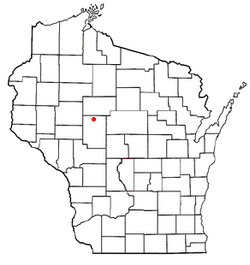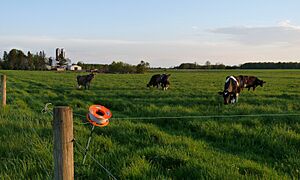Hixon, Wisconsin facts for kids
Quick facts for kids
Hixon, Wisconsin
|
|
|---|---|

Town hall
|
|

Location of Hixon, Wisconsin
|
|
| Country | |
| State | |
| County | Clark |
| Area | |
| • Total | 33.7 sq mi (87.4 km2) |
| • Land | 33.3 sq mi (86.4 km2) |
| • Water | 0.4 sq mi (1.0 km2) |
| Elevation | 1,266 ft (386 m) |
| Population
(2000)
|
|
| • Total | 740 |
| • Density | 22.2/sq mi (8.6/km2) |
| Time zone | UTC-6 (Central (CST)) |
| • Summer (DST) | UTC-5 (CDT) |
| Area code(s) | 715 & 534 |
| FIPS code | 55-35050 |
| GNIS feature ID | 1583395 |
| PLSS township | T29N R2W |
Hixon is a small town located in Clark County, Wisconsin, in the United States. In the year 2000, about 740 people lived there. Interesting fact: parts of the village of Withee and the city of Owen are actually inside Hixon! There's even a "ghost town" called Clark within its borders.
Contents
Exploring Hixon's Landscape
Hixon covers an area of about 33.7 square miles (87.4 square kilometers). Most of this area is land, with only a small part (about 0.4 square miles or 1.0 square kilometer) being water. The Black River flows through the western side of Hixon.
Flat Land and Ancient Soil
The land in Hixon is mostly flat, except for areas where streams have cut through. The soil here is called Colby silt loam. This special soil comes from "drift," which is material left behind by a very old glacier. Over a long time, erosion has made the land quite level.
Beneath this soil, the ground is made of different kinds of rock. In the northern part of Hixon, you'd find volcanic rocks like schists and hornblende. In the south, the bedrock is Mount Simon sandstone.
Hixon's Past: A Look at Its History
The area that is now Hixon was first mapped out in the summer of 1847 by a team working for the U.S. government. Later, in 1853, another team carefully marked all the corners of the land sections. They walked through forests and swamps, using chains and compasses to measure everything.
Early Descriptions of the Land
After their survey, the team described Hixon's land:
- The surface is mostly flat, except near the Black River.
- The soil is generally "second rate," meaning it's okay for farming but not the best.
- The main trees were White Pine, which were good for lumber.
- There were several large swamps, mostly not good for growing crops.
- Many small streams provided water.
- The Black River was about 150 links (around 99 feet or 30 meters) wide and good for floating logs.
- At that time, there were no settlers living in the area.
How Hixon Got Its Name
An 1873 map showed a much larger "Town of Hixon" that included many areas in the northwest part of Clark County. This early town was named after Gideon C. Hixon, who was an important lumber businessman from La Crosse.
Railroads and Early Settlements
By 1880, the town of Hixon was smaller, but it still included the modern towns of Hixon, Withee, Reseburg, and Longwood. The Wisconsin and Minnesota Railroad was built across the southern part of what is now Hixon. This railroad helped connect different towns and bring more people and businesses to the area.
Early maps also showed wagon roads and a few homes. Important landowners at the time included W.T. Murray, D.J. Spaulding, and N. H. Withee.
Growing Communities and Sawmills
By 1893, more settlers had arrived, especially along French Town Road. A small community called Withee had a school, and there were wagon roads connecting it to other areas. A sawmill was built where the railroad crossed the Black River. Another sawmill, called Owens Mill, was located where the city of Owen would later grow.
Around 1894, a man named John S. Owen bought timber land and sawmills in the area. He moved a sawmill and rebuilt it, which led to the start of the city of Owen. Around 1902, Owen's company worked with the Wisconsin Central Railroad to build a new rail line that cut across Hixon, connecting Owen to Ladysmith.
More Settlers and New Businesses
A 1906 map shows the new village of Owen and the new railroad. More roads had been built, and settlers were moving into almost all areas. Many people north of Withee were from Scandinavia, part of a Danish community. Rural schools appeared, and a cemetery was marked at Riverside for the first time.
By 1920, almost the entire town was settled. Cheese factories started appearing on maps, showing how farming and dairy production were growing in the area. These factories were located near Withee, between Withee and Owen, and near Amber (which is now sometimes called Clark).
Hixon's Population
In the year 2000, Hixon had 740 residents. Most of the people living in Hixon were White (99.32%). A very small number were Asian or from other backgrounds. About 0.81% of the population identified as Hispanic or Latino.
Households and Families
There were 232 households in Hixon in 2000. A household is a group of people living together. Out of these, 180 were families.
- About 41.8% of households had children under 18 living with them.
- Most households (68.5%) were married couples living together.
- The average household had about 3.19 people, and the average family had about 3.65 people.
Age Groups in Hixon
The population of Hixon was spread across different age groups:
- 35.8% were under 18 years old.
- 6.1% were between 18 and 24.
- 25.9% were between 25 and 44.
- 18.5% were between 45 and 64.
- 13.6% were 65 years old or older.
The median age (the middle age of the population) was 32 years. This means half the people were younger than 32 and half were older. For every 100 females, there were about 105.6 males.
See also
 In Spanish: Hixon (Wisconsin) para niños
In Spanish: Hixon (Wisconsin) para niños


